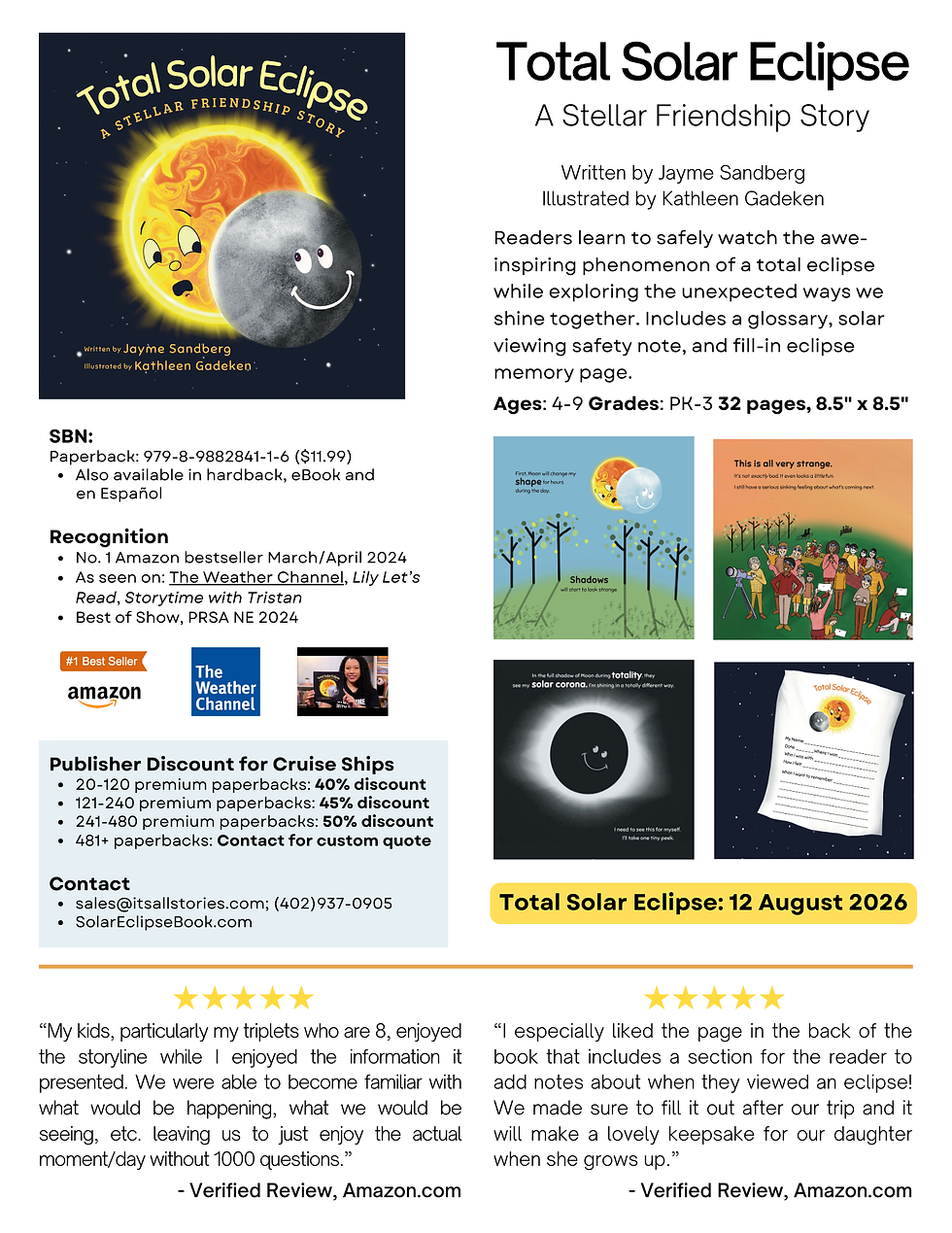5 myths about the total solar eclipse
- It's All Stories

- Feb 14, 2024
- 4 min read

There’s a lot of information out there about the total solar eclipse coming up on April 8, 2024. Most of it’s great, but some of it’s a little confusing, at best. Read on to clear up five myths you may have come across.
Myth #1:
I’ll be close enough to totality.
Fact:
You are either in totality, or you’re not. It's that simple. You could be a mile away and miss it completely. Totality has been compared to being outside the theater looking at the marquee and sitting in the front row for the live performance. One is infinitely better than the other!
Unless you’re in the full shadow (totality), the Moon will not completely cover the Sun and it will never be safe to look at the eclipse without a special filter, which for most people is a pair of solar eclipse glasses. Totality is the only time you get a chance to see the Sun’s incredible atmosphere, called the solar corona. You won't want to miss that!
And while we’re dispelling myths, if you think you’ve seen a total solar eclipse but aren’t sure, you haven't.

Myth #2:
If I don’t have solar eclipse glasses, I can’t see the eclipse.
Fact:
You can still safely view a solar eclipse without solar eclipse glasses, but (and this is a big BUT) you can’t look at it directly with your naked eye except during the few minutes of totality of a total solar eclipse. During totality, the Sun's atmosphere (called the solar corona), is a million times fainter than the Sun itself.
There’s a good chance solar eclipse glasses will get scarce right before the solar eclipse on April 8. If you find yourself without a pair, don’t despair! You can use indirect methods of viewing the crescent shape, like a pinhole projector, tree leaves, or even a kitchen colander.
The partial solar eclipse—when you see that crescent shape of varying sizes—is visible for a couple of hours. It’s easy to share glasses with others around you and people are happy to lend you theirs.
The great news is you don’t need solar glasses to see totality, that brief couple of minutes when the Sun is completely obscured by the Moon when you’re in the direct path of totality. In fact, if you have solar eclipse glasses on during totality, you’ll completely miss it because the solar corona is so much fainter than the Sun itself (see above).
However, as soon as the Sun’s disk starts to appear again, you need to look away or put on the protective filters right away. Totality only lasts up to a few minutes so keep those safe solar viewers close by.

Myth #3:
If I miss this one, I’ll catch the next one that comes through.
Fact:
While total solar eclipses happen somewhere on Earth about every 18 months, it’s exceptionally rare to see one where you live. Research averages that any one spot on Earth will see a total eclipse about every 375 years. If you have the chance to see one in your own backyard, or within easy traveling distance, don’t pass it up. The next total eclipse in the U.S. isn’t until 2044.

Myth #4:
A lot of people will go blind watching a solar eclipse.
Fact:
When people know what to do, they follow the safety rules.
Thanks to public education, after the Great American Eclipse of 2017, there were very few reported cases of permanent eye damage from viewing the solar eclipse, even though an estimated 215 million Americans watched it.
One eye doctor along the path of totality said they were prepared for a flood of calls, and it was completely underwhelming with not one incident he was aware of regionally.
Still, caution must be taken and children especially should be clearly taught about eclipse eye safety and closely observed during the event. Books like Total Solar Eclipse: A Stellar Friendship Story can help even the youngest eclipse watchers learn how to view it safely.
To directly look at the Sun during the partial eclipse (when any part of the Sun’s disk is showing) you must wear specially designed and approved solar viewing glasses or use some other approved solar filter. Another option is to look at the eclipse indirectly, using a pinhole projector, for example.
Never attempt to view a partial solar eclipse with the naked eye! Remember, the only time it’s safe to look directly at an eclipse is during totality of a total solar eclipse, when no part of the Sun’s bright disk is visible. You’ll know you can take those fashionable eclipse viewers off when you can no longer see the Sun’s image by looking through them. At the very first glimpse of the Sun’s bright light again, the viewers need to go back on immediately.

Myth #5:
Solar eclipses are a sign of impending doom.
Fact:
Solar eclipses are completely explained by math and science as natural occurrences. While there is no evidence that they are a sign of vengeful gods or impending doom, some cultures choose not to view them directly or choose to celebrate them in indirect ways. We encourage everyone to respect and honor others’ beliefs and customs around the eclipse.





Comments